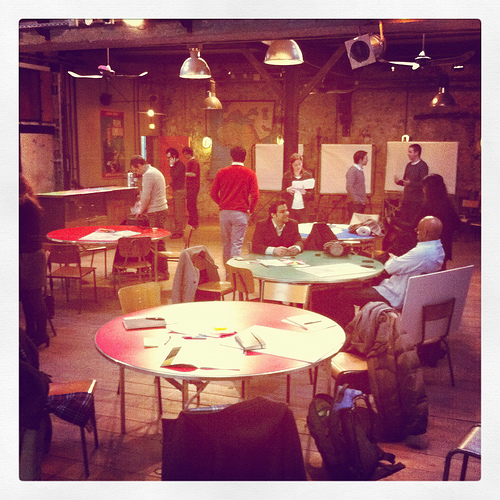
I was invited this week to Sony FutureScapes – a project which brings together a wide range of people to explore lifestyles in 2025. Sony is yet another organization which embraces crowdsourcing as a way to generate concepts and test new ideas. This project also leverages social media and the community at large to contribute more ideas. Many organizations are resorting to crowdsourcing not just for idea generation but also funding or cracking complex problems. See for instance Kickstarter or Kaggle. Organizing events which involve people from various backgrounds to generate ideas in a short time-frame (1.5 days) requires solid facilitation and a plan. This was provided by Forum for the Future (Forum), a UK-based consultancy focusing on environmental solutions and sustainable futures.
The workshop was structured in two parts: half-a-day for setting the context and a full day for ideation. The context was set by presenting a number of studies and key issues we are facing today. These are fairly well covered elsewhere. Check out OurWorld 2.0 for example.
- Demographic changes
- Rising costs of resources
- Growing impact of climate change
- Increased transparency demands from supply-chains
- Food and water security
- Spread of information and communication technology
- Loss of biodiversity
- Energy security
Based on these, Sony and Forum had already prepared four possible scenarios for 2025. Participants were the assigned to one scenario. I ended up working on Prosperity Redefined.
Prosperity Redefined
What is the potential contribution that technology and entertainment can make in shaping a better, more sustainable future in this world? What are the characteristics of Prosperity Redefined anyway? Below are some projections for 2025 under this particular scenario which I was assigned to:
- GDP is no longer the measure by which prosperity is measured
- Departure from growth
- Neighborhood re-discovered; emphasis on relationships
- Technology used to make the invisible visible
- Increased oriental influence on culture
- Markerspaces : community spaces with 3D printers, advanced design software to make complex items
These projections are in line with the ideas put forward by Juliet Schor in Plenitude: The New Economics of True Wealth or Tim Jackson in Prosperity Without Growth. In his book, Prof. Jackson proposes changes in national accounting standards to incorporate our impact on the environment. National accounting methods balance aggregate demand (aka GDP) with a production function of traditionally only two parameters: labor and capital. Jackson suggests the following improvements:
- incorporate explicit reference to energy resources,
- incomplete substitutability of production factors,
- and tracking resource usage improvements.
The point about substituting production factors relates to the notion of weak or strong sustainability, i.e. the approach to trade-offs between social, economic and environmental concerns. Reaching this new state of affairs in which GDP growth is no longer the accepted norm will presumably take some time.
Prof. Schor proposes a strategy she calls Plenitude for a society morphing from business-as-usual to the new descent economies envisioned by Tim Jackson. The four principles behind Plenitude:
- re-allocation of time (think slow movements freeing capabilities for community activities), self-provision (e.g. fab labs
- local agriculture)
- an environmentally-aware approach to consumerism
- and finally focus on one another and our communities.
It’s a view of Less is More which adheres to the principles of work less, buy less, create more and connect more opposing the current work hard, spend hard mentality.
Some Thoughts
Prosperity Redefined is a rather challenging scenario for a consumer electronics company. Furthermore, Sony finds itself most likely at a crucial crossroads today. To make brainstorming for ideas even more tricky, sustainable development adheres to fundamental principles one of which being normativity which refers to the fact it is socially constructed and depends entirely on the kind of society your living in or addressing.
During the preparation afternoon preceding the actual workshop, a prediction was made regarding multi-function devices as opposed to single-function ones. The example given was the iPhone. The shift from single-purpose to multi-purpose seems being one way to address carbon footprint reductions by manufacturers such as Sony. Here’s also an example by Motorola.
What about self-provisioning? Could Sony further push the innovations provided today by MakerBot Industries? These multi-purpose printers are definitely part of a future where communities like to repair stuff rather than purchasing more of them. What about the Global Village Construction Set which also contributes a PicoCricket-like approach to farming, building and manufacturing. Consider the fact that Danone re-engineered its ultra-sophisticated factories to enter markets such as Bengladesh by downsizing and adapting machines to the local labor capabilities.
What about norms and values? Sony is a Japanese company. Considering that urban planners see Tokyo as model city of the future with its tremendous density levels, the company may be well positioned to identify best practices applicable to an urbanized world. One thing that comes to my mind are Tokyo’s neighborhoods"> and how local communities organize themselves around Shinto shrines and non-codified traditions for community organization.
One area of consumer electronics which we didn’t explore during the workshop was Radio. An ancient social media. Although Japan seems to laugh at global standards, Sony has the skills to take radio to the level required for Prosperity Redefined in which communities thrive through Plenitude principles. Recent advances in radio such as RadioDNS which unites broadcast and IP features, lets us imagine interesting applications which transmit not only audio but also data perhaps to local Ninja blocks for urban gardening. Just consider that while all eyes are on Facebook, radio is still evolving.
Tck Tck Tck
2025 is 13 years away. About 5 years less than it took for the Walkman to appear, shine and retire. The iPod broke the 30 Million units mark in 5 years (I know, a consumerism observation). My point is that 13 years at ever accelerated paces gives us some time to innovate and prepare for the future. Why don’t you check out the other scenarios and come up with your ideas for FutureScapes? FutureScapes would love to hear from you.
 This material is licensed under CC BY 4.0
This material is licensed under CC BY 4.0
